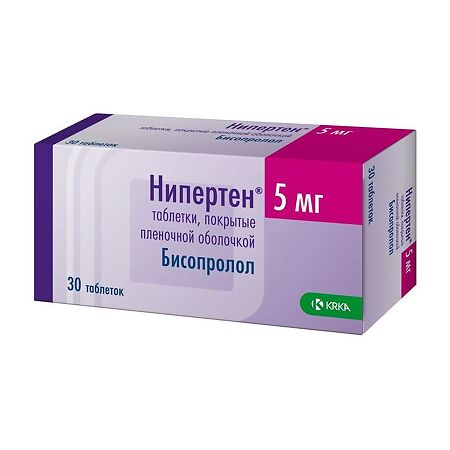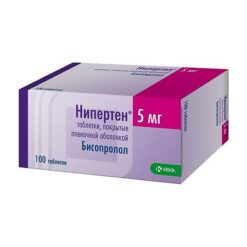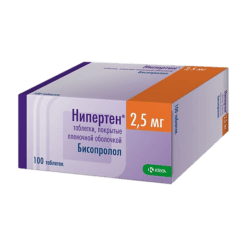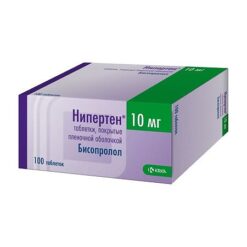No products in the cart.
Niperten, 5 mg 30 pcs
€1.00
Out of stock
(E-mail when Stock is available)
Description
Heart failure, Tachycardia, Arrhythmia, Cardialgia (heart pain), Hypertension (high blood pressure)
– Arterial hypertension.
– Coronary heart disease: stable angina.
– Chronic heart failure.
Indications
Indications
· Arterial hypertension.
· Coronary heart disease: stable angina.
· Chronic heart failure.
Pharmacological effect
Pharmacological effect
selective beta1-blocker
Special instructions
Special instructions
Carrying out desensitizing therapy, Prinzmetal’s angina, hyperthyroidism, type 1 diabetes mellitus and diabetes mellitus with significant fluctuations in blood glucose concentration, AV block of the first degree, severe renal failure (creatinine clearance (CC) less than 20 ml/min), severe liver dysfunction, psoriasis, restrictive cardiomyopathy, congenital heart defects or heart valve disease with severe hemodynamic disorders, CHF with myocardial infarction within the last 3 months, severe forms of chronic obstructive pulmonary disease, strict diet
Since there is not enough data on the use of Niperten® in children, it is not recommended to use the drug in children under 18 years of age.
Impaired kidney or liver function
For mild or moderate hepatic or renal dysfunction, no dosage adjustment is usually required.
In severe renal impairment (creatinine clearance less than 20 ml/min.) and in patients with severe liver disease, the maximum daily dose is 10 mg. Increasing the dose in such patients should be carried out with extreme caution.
Elderly patients
No dose adjustment is required.
Do not interrupt treatment with Niperten® abruptly or change the recommended dose without first consulting your doctor, as this may lead to a temporary deterioration in heart function. Treatment should not be interrupted suddenly, especially in patients with coronary artery disease. If discontinuation of treatment is necessary, the dose should be reduced gradually.
When using clonidine simultaneously, its use can be discontinued only a few days after discontinuation of the drug Niperten®.
At the initial stages of treatment with Niperten®, patients require constant monitoring.
Monitoring the condition of patients taking the drug Niperten® should include measuring heart rate and blood pressure (at the beginning of treatment – daily, then once every 3-4 months), conducting an electrocardiogram, determining the concentration of glucose in the blood in patients with diabetes (once every 4-5 months). In elderly patients, it is recommended to monitor renal function (once every 4-5 months).
The patient should be taught how to calculate heart rate and instructed to consult a doctor if the heart rate is less than 60 beats/min.
Niperten® should be used with caution in the following cases:
· severe forms of COPD and non-severe forms of bronchial asthma;
· diabetes mellitus with significant fluctuations in plasma glucose concentration: symptoms of a pronounced decrease in glucose concentration (hypoglycemia) such as tachycardia, palpitations or increased sweating may be masked;
· strict diet;
· carrying out desensitizing therapy;
· AV block of the first degree;
· Prinzmetal’s angina;
mild to moderate peripheral arterial circulatory disorders (increased symptoms may occur at the beginning of therapy);
· psoriasis (including history).
If increasing bradycardia (heart rate less than 60 beats/min), a pronounced decrease in blood pressure (systolic blood pressure below 100 mm Hg), AV block, bronchospasm, ventricular arrhythmias, severe impairment of liver and/or kidney function is detected in elderly patients, it is necessary to reduce the dose of the drug or discontinue treatment.
It is recommended to discontinue therapy if depression caused by taking β-blockers develops.
Respiratory system
Before starting therapy, it is recommended to conduct a study of external respiratory function in patients with a burdened bronchopulmonary history.
For bronchial asthma or COPD, simultaneous use of bronchodilators is indicated. In patients with bronchial asthma, there may be an increase in airway resistance, which requires a higher dose of β2-adrenergic agonists.
In smokers, the effectiveness of β-blockers is lower. In patients with COPD, bisoprolol prescribed in combination therapy for the treatment of heart failure should be started at the lowest possible dose, and patients should be carefully monitored for the development of new symptoms (eg, shortness of breath, exercise intolerance, cough).
Allergic reactions
β-blockers, including Niperten®, may increase sensitivity to allergens and the severity of anaphylactic reactions due to weakening of their adrenergic compensatory regulation under the influence of β-blockers. Therapy with epinephrine (adrenaline) does not always give the expected therapeutic effect.
General anesthesia
When performing general anesthesia, the risk of β-adrenergic receptor blockade should be taken into account. If it is necessary to discontinue Niperten® therapy before surgery, this should be done gradually and completed 48 hours before general anesthesia. You should warn your anesthesiologist that you are taking Niperten®.
Pheochromocytoma
In patients with an adrenal tumor (pheochromocytoma), the drug Niperten® can only be used against the background of simultaneous use of α-blockers.
Hyperthyroidism
When treated with Niperten®, symptoms of hyperthyroidism (hyperthyroidism) may be masked.
Patients using contact lenses should take into account that during treatment there may be a decrease in the production of tear fluid.
The drug Niperten® does not affect the ability to drive vehicles, according to the results of a study in patients with coronary artery disease. However, due to individual reactions, the ability to drive vehicles or operate technically complex mechanisms may be impaired. Particular attention should be paid to this at the beginning of treatment, after changing the dose, and also when consuming alcohol at the same time.
Active ingredient
Active ingredient
Bisoprolol
Composition
Composition
per 1 tablet 2.5 mg/5 mg/10 mg
Core:
Active ingredient:
Bisoprolol fumarate 2.50 mg/5.00 mg/10.00 mg
Excipients: microcrystalline cellulose, sodium carboxymethyl starch, povidone-K30, colloidal silicon dioxide, magnesium stearate
Film coating: hypromellose, macrogol 400, titanium dioxide (E 171) 0.42 mg, talc
Pregnancy
Pregnancy
Pregnancy
During pregnancy, Niperten® should be recommended for use only if the benefit to the mother outweighs the risk of side effects in the fetus and/or child.
In general, beta-blockers reduce blood flow to the placenta and may affect fetal development. Blood flow in the placenta and uterus should be monitored, as well as the growth and development of the unborn child should be monitored, and if adverse events occur in relation to pregnancy and/or the fetus, alternative therapies with a proven safety profile for use during pregnancy should be taken. The newborn should be carefully examined after birth. In the first three days of life, symptoms of bradycardia and hypoglycemia may occur.
Breastfeeding period
There is no data on the excretion of bisoprolol into breast milk. Therefore, taking Niperten® is not recommended for women during breastfeeding. If taking Niperten® during lactation is necessary, breastfeeding should be stopped.
Contraindications
Contraindications
· Hypersensitivity to bisoprolol or to any of the excipients (see section “Composition”).
· Acute heart failure, chronic heart failure in the stage of decompensation, requiring inotropic therapy.
· Cardiogenic shock.
· Atrioventricular (AV) block II and III degrees, without a pacemaker.
· Sick sinus syndrome.
· Sinoatrial blockade.
· Severe bradycardia (heart rate less than 60 beats/min).
· Severe arterial hypotension (systolic blood pressure less than 100 mmHg).
· Severe forms of bronchial asthma.
· Severe peripheral arterial circulation disorders or Raynaud’s syndrome.
· Pheochromocytoma (without simultaneous use of alpha-blockers).
· Metabolic acidosis.
· Age under 18 years (insufficient data on effectiveness and safety in this age group).
Side Effects
Side Effects
The frequency of adverse reactions listed below was determined according to the following criteria recommended by the World Health Organization: very often (≥ 1/10); often (≥ 1/100 to < 1/10); uncommon (≥ 1/1000 to < 1/100); rare (≥ 1/10000 to < 1/1000); very rare (<1/10000).
Nervous system disorders:
often: dizziness*, headache*;
rarely: loss of consciousness.
Mental disorders:
uncommon: depression, insomnia;
rarely: hallucinations, nightmares.
Visual disorders:
rarely: decreased tear production (should be taken into account when wearing contact lenses);
very rare: conjunctivitis.
Hearing and labyrinth disorders:
rarely: hearing loss.
Disorders of the heart and blood vessels:
very often: bradycardia (in patients with CHF);
often: worsening symptoms of CHF (in patients with CHF), a feeling of coldness or numbness in the extremities, a marked decrease in blood pressure, especially in patients with CHF;
uncommon: AV conduction disturbance, bradycardia (in patients with arterial hypertension or angina pectoris), worsening of symptoms of CHF (in patients with arterial hypertension or angina pectoris), orthostatic hypotension.
Disorders of the respiratory system, chest and mediastinal organs:
uncommon: bronchospasm in patients with a history of bronchial asthma or airway obstruction;
rarely: allergic rhinitis.
Gastrointestinal disorders:
often: nausea, vomiting, diarrhea, constipation.
Disorders of the liver and biliary tract:
rarely: hepatitis.
Musculoskeletal and connective tissue disorders:
uncommon: muscle weakness, muscle cramps.
Disorders of the skin and subcutaneous tissues:
rarely: hypersensitivity reactions such as itching, skin rash, hyperemia of the skin;
very rare: alopecia.
β-blockers may worsen the symptoms of psoriasis or cause a psoriasis-like rash.
Disorders of the genital organs and breast:
rarely: impaired potency.
General disorders and disorders at the injection site:
often: asthenia (in patients with CHF), increased fatigue*;
uncommon: asthenia (in patients with arterial hypertension or angina pectoris).
Laboratory and instrumental data:
rarely: increased concentration of triglycerides and activity of “liver” transaminases (aspartate aminotransferase (ACT), alanine aminotransferase (ALT)) in the blood plasma.
* In patients with arterial hypertension or angina pectoris, these symptoms especially often appear at the beginning of the course of treatment. Typically, these phenomena are mild and usually disappear within 1-2 weeks after the start of treatment.
Interaction
Interaction
The effectiveness and tolerability of bisoprolol may be affected by concomitant use of other medications. This interaction can also occur when two drugs are taken within a short period of time.
It is necessary to inform your doctor if you are taking other medications, even if you are taking them without a doctor’s prescription (i.e., over-the-counter medications).
Not recommended combinations
Treatment of chronic heart failure
Class I antiarrhythmic drugs (for example, quinidine, disopyramide, lidocaine, phenytoin, flecainide, propafenone), when used simultaneously with bisoprolol, can reduce AV conduction and myocardial contractility.
All indications for use of the drug Niperten®
Blockers of “slow” calcium channels (SCBC) such as verapamil and, to a lesser extent, diltiazem, when used simultaneously with bisoprolol, can lead to a decrease in myocardial contractility and impaired AV conduction. In particular, intravenous administration of verapamil to patients taking beta-blockers can lead to severe arterial hypotension and AV block. Centrally acting antihypertensives (such as clonidine, methyldopa, moxonidine, rilmenidine) can lead to a decrease in heart rate and cardiac output, as well as vasodilation due to a decrease in central sympathetic tone. Abrupt withdrawal, especially before discontinuation of beta-blockers, may increase the risk of developing rebound hypertension.
Combinations requiring special caution
Treatment of arterial hypertension and angina pectoris
Class I antiarrhythmic drugs (for example, quinidine, disopyramide, lidocaine, phenytoin, flecainide, propafenone), when used simultaneously with bisoprolol, can reduce AV conduction and myocardial contractility.
All indications for use of the drug Niperten®
BMCC, dihydropyridine derivatives (for example, nifedipine, felodipine, amlodipine), when used simultaneously with bisoprolol, may increase the risk of developing arterial hypotension. In patients with CHF, the risk of subsequent deterioration in cardiac contractility cannot be excluded.
Class III antiarrhythmic drugs (eg, amiodarone) may worsen AV conduction disturbances.
The effect of topical β-blockers (for example, eye drops for the treatment of glaucoma) may enhance the systemic effects of bisoprolol (lowering blood pressure, lowering heart rate).
Parasympathomimetics, when used simultaneously with bisoprolol, may increase AV conduction disturbances and increase the risk of developing bradycardia.
The hypoglycemic effect of insulin or oral hypoglycemic agents may be enhanced. Signs of hypoglycemia, in particular tachycardia, may be masked or suppressed. Such interactions are more likely when using non-selective beta-blockers.
General anesthesia agents may increase the risk of cardiodepressive effects, leading to arterial hypotension (see section “Special Instructions”).
Cardiac glycosides, when used simultaneously with bisoprolol, can lead to an increase in impulse conduction time, and thus to the development of bradycardia.
Nonsteroidal anti-inflammatory drugs (NSAIDs) may reduce the antihypertensive effect of bisoprolol.
The simultaneous use of Niperten® with β-adrenergic agonists (for example, isoprenaline, dobutamine) may lead to a decrease in the effect of both drugs. The use of bisoprolol with adrenergic agonists that affect α- and β-adrenergic receptors (for example, norepinephrine, epinephrine) may enhance the vasoconstrictor effects of these drugs that occur with the participation of α-adrenergic receptors, leading to an increase in blood pressure. Such interactions are more likely when using non-selective beta-blockers.
Antihypertensive drugs, as well as other drugs with a possible antihypertensive effect (for example, tricyclic antidepressants, barbiturates, phenothiazines) may enhance the antihypertensive effect of bisoprolol.
Mefloquine, when used simultaneously with bisoprolol, may increase the risk of bradycardia.
Monoamine oxidase (MAO) inhibitors (except MAO B inhibitors) may enhance the antihypertensive effect of beta-blockers. Concomitant use may also lead to the development of a hypertensive crisis.
Overdose
Overdose
Symptoms
The most common symptoms of overdose: AV block, severe bradycardia, marked decrease in blood pressure, bronchospasm, acute heart failure and hypoglycemia.
Sensitivity to a single high dose of bisoprolol varies widely among individual patients and patients with CHF are likely to be highly sensitive.
Treatment
If an overdose occurs, first of all, it is necessary to stop taking the drug and begin supportive symptomatic therapy.
For severe bradycardia: intravenous atropine. If the effect is insufficient, a drug with a positive chronotropic effect can be administered with caution. Sometimes temporary placement of an artificial pacemaker may be necessary.
With a pronounced decrease in blood pressure: intravenous administration of plasma-substituting solutions and vasopressor drugs.
For AV block: Patients should be closely monitored and treated with α- and β-adrenergic agonists such as epinephrine (adrenaline). If necessary, install an artificial pacemaker.
In case of exacerbation of CHF: intravenous administration of diuretics, drugs with a positive inotropic effect, as well as vasodilators.
For bronchospasm: use of bronchodilators, including β2-adrenergic agonists and/or aminophylline.
For hypoglycemia: intravenous administration of dextrose (glucose).
Clinical pharmacology
Clinical pharmacology
Pharmacodynamics
A selective β1-blocker, without its own sympathomimetic activity, does not have a membrane-stabilizing effect. It has only slight affinity for β2-adrenergic receptors of the smooth muscles of the bronchi and blood vessels, as well as for β2-adrenergic receptors involved in the regulation of metabolism. Therefore, bisoprolol generally does not affect airway resistance and metabolic processes in which β2-adrenergic receptors are involved.
The selective effect of the drug on β1-adrenergic receptors persists beyond the therapeutic range.
Bisoprolol does not have a pronounced negative inotropic effect. The maximum effect of the drug is achieved 3-4 hours after oral administration. Even when bisoprolol is used once a day, its therapeutic effect persists for 24 hours due to a 10-12-hour half-life (T1/2) from the blood plasma. As a rule, the maximum reduction in blood pressure (BP) is achieved 2 weeks after the start of treatment.
Bisoprolol reduces the activity of the sympathoadrenal system by blocking β1-adrenergic receptors of the heart.
When administered once orally in patients with coronary heart disease (CHD) without signs of chronic heart failure (CHF), bisoprolol reduces the heart rate (HR), reduces the stroke volume of the heart and, as a result, reduces the ejection fraction and myocardial oxygen demand. With long-term therapy, the initially increased total peripheral vascular resistance decreases. A decrease in renin activity in blood plasma is considered as one of the components of the antihypertensive effect of β-blockers.
Pharmacokinetics
Suction
Bisoprolol is almost completely (more than 90%) absorbed from the gastrointestinal tract. Its bioavailability due to negligible first pass metabolism through the liver (approximately 10%) is approximately 90% after oral administration. Food intake does not affect bioavailability. Bisoprolol exhibits linear kinetics, with its plasma concentrations being proportional to the dose taken in the range from 5 to 20 mg. The maximum concentration in blood plasma is achieved after
2-3 hours.
Distribution
Bisoprolol is distributed quite widely. The volume of distribution is 3.5 l/kg. The connection with blood plasma proteins reaches approximately 30%.
Metabolism
Metabolized via the oxidative pathway without subsequent conjugation. All metabolites are polar (water-soluble) and are excreted by the kidneys. The main metabolites found in blood plasma and urine do not exhibit pharmacological activity. Data obtained from experiments with human liver microsomes in vitro show that bisoprolol is metabolized primarily by the CYP3A4 isoenzyme (about 95%), and the CYP2D6 isoenzyme plays only a minor role.
Withdrawal
The clearance of bisoprolol is determined by the balance between excretion by the kidneys unchanged (about 50%) and metabolism in the liver (about 50%) to metabolites, which are also excreted by the kidneys. The total clearance is 15 l/hour. T1/2 – 10-12 hours.
Pharmacokinetics in different patient groups
There is no information on the pharmacokinetics of bisoprolol in patients with CHF and concurrent impairment of liver or kidney function.
Storage conditions
Storage conditions
At a temperature not exceeding 25 °C, in the original packaging.
Keep out of the reach of children.
Shelf life
Shelf life
2 years.
Do not use the drug after the expiration date.
Manufacturer
Manufacturer
KRKA-RUS, Russia
Additional information
| Shelf life | 2 years. Do not use the product after the expiration date. |
|---|---|
| Conditions of storage | At temperature not exceeding 25°C, in original packaging. Store out of reach of children. |
| Manufacturer | KRKA dd Novo mesto, Slovenia |
| Medication form | pills |
| Brand | KRKA dd Novo mesto |
Other forms…
Related products
Buy Niperten, 5 mg 30 pcs with delivery to USA, UK, Europe and over 120 other countries.


















